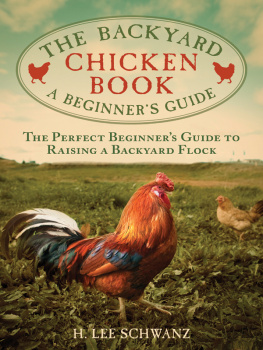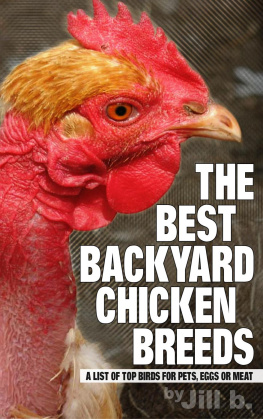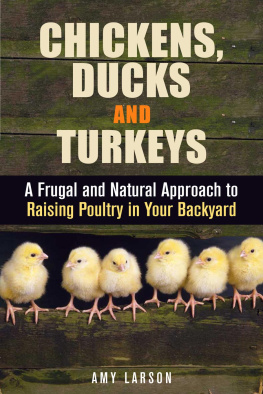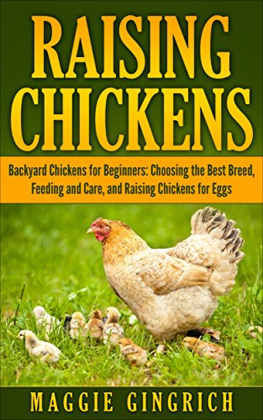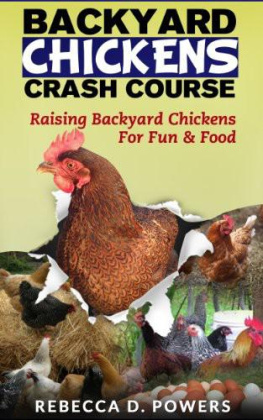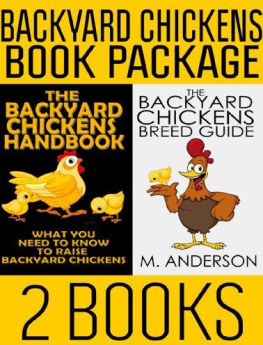Copyright 2014 Skyhorse Publishing
Revised and updated from the book originally published as The Family Poultry Flock 1979 by Farmers Digest, Inc.
All Rights Reserved. No part of this book may be reproduced in any manner without the express written consent of the publisher, except in the case of brief excerpts in critical reviews or articles. All inquiries should be addressed to Skyhorse Publishing, 307 West 36th Street, 11th Floor, New York, NY 10018.
Skyhorse Publishing books may be purchased in bulk at special discounts for sales promotion, corporate gifts, fund-raising, or educational purposes. Special editions can also be created to specifications. For details, contact the Special Sales Department, Skyhorse Publishing, 307 West 36th Street, 11th Floor, New York, NY 10018 or .
Skyhorse and Skyhorse Publishing are registered trademarks of Skyhorse Publishing, Inc., a Delaware corporation.
Visit our website at www.skyhorsepublishing.com.
All photos are from Thinkstock.
10 9 8 7 6 5 4 3 2 1
Library of Congress Cataloging-in-Publication Data is available on file
ISBN: 978-1-62914-204-3
Printed in China
This book is dedicated to my mother, Rae Cafferey Schwanz, who taught me most of what I know about chickens. She ran the poultry enterprise on our Iowa farm a generation ago. As soon as I was big enough to carry a bucket of feed or a pail of water, I became her assistant.
She taught me to wonder at the miracle of the hatching chicks and the joy of watching the downy bird learn to scratch for life. She also knew how to fry a chicken the way it could make a small boys stomach squirm with anticipation.
We hatched about 500 chickens each spring. These were straight-run chicks, so we had plenty of roosters to eat all summer and fall. Each Saturday, year around, there was at least one crate of eggs to haul to town and sometimes more.
Looking back, the chicken business really hasnt changed that much, at least for small flocks. The equipment shown here is virtually the same. The Leghorns we raised still are the most popular egg breed.
Our farm was a leading example of what now is known as the Protestant work ethic. This, boiled down to its basic meaning, is If its hard work it must be right. My father was very progressive in field work and in livestock selection but we really made hard work out of chores. Every pound of feed and gallon of water was carried more than 100 yards both to the hen house and to the growing chickens.
If I could go back over the years and give my mother one gift, it would be running water for the chickens and a more willing boy to help carry the feed and gather the eggs.
Contents
Introduction
OUR FAMILY MADE THE DECISION to be in the egg business and a flock of 400 or so hens was large for that time. Most farms had a few birds of the heavy breeds that got very little care. They scratched around the barnyard picking up a kernel here and a kernel there. Hunting eggs around the barn was an exciting chore for kids.
Our hens were confined in a two-room henhouse. Pullets were in one room and the yearling hens in another. We gathered eggs twice a day, candled them in the basement, and took them to town when the 30-dozen case was filled.
We sold cattle and hogs a half-dozen times a year, but it was the eggs that bought the weekly staples at the grocery store.
Like other farms, we also relied on the flock for food. There were eggs for breakfast every day and two or three for the hard workers in the family seemed about right. We ate a lot of fried chicken, too.
In this chapter, we talk about making a decision on the kind of poultry enterprise you want for your family. Egg income plus family food was our goal. It fit our family, our farm buildings, and the market situation at that particular time. Your needs, facilities, and desires are different select your chickens to fit your own individual family situation.

Chapter 1
What you can expect from a family poultry flock
A SMALL FLOCK OF POULTRY can supply all of the eggs your family needs during the year. There also can be some broilers for barbeque or frying. After the hen has completed her egg-laying days, she can provide the family with chicken stew or other dishes.
A small flock takes a relatively small amount of space. Management is not difficult, but the flock requires attention every day. Someone in the family must care enough about the flock to make sure they have feed, water, and egg gathering on a regular basis.
The first step in deciding on a family flock is to determine what you really want. You can go with a laying breed such as the White Leghorn that produces top quality eggs but provides little meat. You can select a dual-purpose Rhode Island Red or New Hampshire that provides fewer eggs but much better meat. Another alternative is to select fast-growing broiler chickens that are ready to eat in eight weeks or less.
Whatever type you select for the home flock you must realize that you probably arent going to make money if you put a value on your time.
Commercial egg production is a big business. These farms are mechanized and highly efficient. They can put eggs in your supermarket for little more money than it will cost you to produce them.
The broiler business also is concentrated in giant factories. Chicks are raised on computerized feed formulas and are ready for market in six weeks or less. Automated packing plants process the birds, package them, and deliver them to stores in big volume. Again, it is tough to compete.
Set your sights on a flock that provides for the needs of your own family. Take your reward in fresh eggs and meat. If you can sell the surplus, consider that an extra benefit.
How big a flock?
Determine how many hens you will need to supply your daily consumption of eggs. It may be a month from the time you find the first egg until the hens are laying at their highest rate. Twelve hens at their peak of production will probably produce a total of nine to ten eggs daily for several weeksperhaps for two to three months. As they age, they will gradually lay at a lesser rate until the twelfth month when you could expect six eggs each day. Dont be surprised at daily fluctuations. On some days, all twelve hens may lay; on other days, only seven or eight. Hens are adversely affected by bad weather, dark days, severe cold, frozen water, or lack of feed.
Most family laying flocks are in the 20 to 25 hen range. It doesnt take any more time or effort for a few extra birds.
The average hen usually produces eggs economically for 12 months. During that time, she will lay from 17 to 19 dozen. She will also eat an average of five pounds of feed per dozen eggs produced.
What are the costs?
It is about as difficult to estimate costs for the home chicken flock as it is for lawn and garden projects. People have widely varying attitudes about investing in items that add interest to the project. Logic and strict economy do not typically govern all decisions.
Some persons will have poultry housing for little or no cost. Others will want to use their handyman skills in the home shop to build an attractive unit which will fit well into the landscape.
Ask yourself these questions
Your answers to the following questions will help you decide whether you want and can afford to raise your own poultry.

